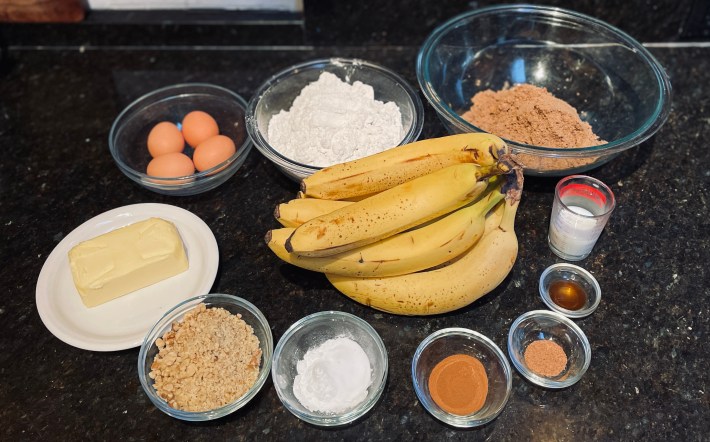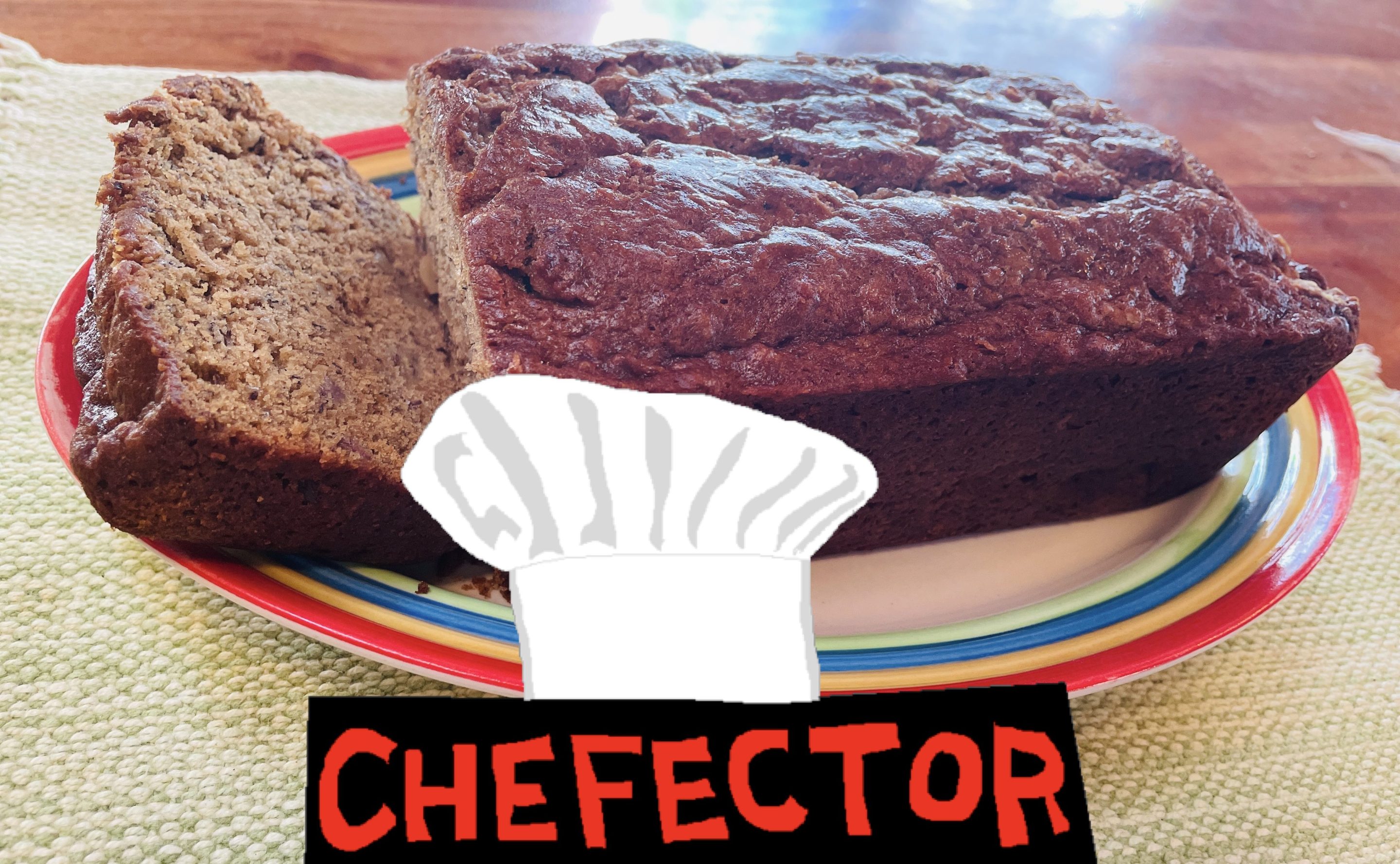It has taken a while to calibrate how to shop for groceries in these awful pandemic times. I don't want to go to the store absolutely any more often than necessary—in fact, I dread going—but not all of the things on a typical grocery list can just be bought in two-week quantities. That has not always stopped me from trying.
What I'm getting at here is that I've had an awful lot of brown bananas sitting around over the past year. I'm the only person in my household who doesn't prefer bananas slightly underripe, and I'm not exactly Donkey Kong even for ones at my ideal level of ripeness (no green left on the peel, some minor brown speckling here and there); if nobody has eaten the bananas by the time they ripen, it's very likely that some of them will just sit around until they're brown.
That's not quite a problem the way it is when I reach for a clementine and discover that it has blue fuzz growing on its mushy underside. I can't bake delicious sweet treats out of slimy old clementines, but I can bake banana bread out of brown bananas. You could say that it's a welcome development when a banana sits around for an extra day or two. Why, you might even say that I have considered hiding caches of bananas in strategic locations around my home so that at certain junctures I can pull one out, go "Oh darn, these 36 bananas are overripe, looks like I'll have to bake a loaf of banana bread the size of a Rottweiler and eat the entire thing." In perhaps related news, I'm like 47 pounds heavier right now than I was back when the first big wave of COVID-19 restrictions hit in March.
Maybe you, too, would like to dispose of some aging bananas and/or have an excuse to buy way more bananas than you would ordinarily eat and then pretend this gives you an ethical obligation to make dessert out of them. In that case I recommend baking some banana bread. Let's bake some banana bread.
Here are some things you will need.
You will need some aging bananas. About that. A thing with making banana bread is that it's not only a delicious quasi-dessert and/or coffee accompaniment, it's also the best possible way to dispose of some aging bananas. As such, it tends to be the sort of thing where how much of it you make in a given iteration depends on how many aging bananas you have. A standard loaf of extremely good banana bread will have three aging bananas in it; if you can arrange to have three aging bananas at the same time, then you can make one loaf of extremely good banana bread. (You can cram a fourth in there without having to adjust all the other ingredients and it's fine, but no more than that or it'll be weird.) On the other hand, if you have two or six or 247 aging bananas, you will need to perform math on the rest of the ingredients. Let's proceed as though you have three.
If you are making a single loaf of banana bread with three bananas, you will need a cup of sugar. Many banana bread recipes will call for white granulated sugar, and that's fine if it's what you have or what you prefer. I recommend dark brown sugar, not for reasons of Baking Science, but because dark brown sugar tastes better and adds more than mere sweetness to your banana bread. In this and probably most other baking applications, you can switch white sugar out for brown or vice versa at a 1:1 ratio. Suit your dang self!
Next you will need flour. For a single loaf of banana bread, with three bananas and a cup of sugar, you will need two cups of flour. I have only ever used all-purpose flour to make banana bread, and can't rule on the usefulness of, like, rice or oat or any other kind of flour here. Probably some of them are fine?
You will also, I am very sorry to report, need frightening baking ingredients. Here I am talking about baking soda and baking powder, a teaspoon of each. Baking soda is sodium bicarbonate; when it is exposed to acid, the reaction produces carbon dioxide, little bubbles of which get trapped in the baked good and give it a soft, spongy structure. Baking powder is also sodium bicarbonate—the same shit!—but mixed with cornstarch and dry acidic ingredients that react when exposed to water, producing the same effect (leavening) as the baking soda. Baking soda must be combined with an acidic ingredient in order to work; baking powder only needs water to do its job. You use both of them in making your banana bread: The baking soda will react to the minor acidity of the aged bananas (they lose acidity as they ripen) and produce some leavening effect, but not enough to fully lift a batter heavy with mashed banana and brown sugar and egg; the baking powder will do the rest, producing a pleasantly spongy foodstuff. It's fine not to give a shit about any of that, so long as you use a teaspoon of each of those in this recipe. I'm moving on now!
You'll need two eggs. You'll need just a little splash of fatty milk, maybe a tablespoon. You'll need a stick of butter; salted is OK if that's what you have, but most baking preparations insist on unsalted. You need to let the butter come all the way to room temperature. It's not enough for the butter to just be soft! It has to be the level of near-mayonnaise soft that it gets when it has come to room temperature. Otherwise later on, when you're mixing this stuff into other ingredients, you are going to regret it. Please just trust me on this.
You'll need some flavorings. A nice heaping teaspoon of ground cinnamon, maybe half as much ground nutmeg, and, oh, I dunno, maybe a quarter teaspoon of vanilla extract. Your banana bread will be fine if you don't have any of these, but it will be even better if you include them. Along these lines, you emphatically do not need two thirds of a cup of crushed walnuts, but man oh man do they ever sing in a frickin' banana bread. Sometimes people put chocolate chips in their banana bread, and that's fine, but I never have chocolate chips just kind of laying around in my kitchen, and I pretty much always have all of this other stuff. You will definitely need a nice fat pinch of salt.
Also, this isn't quite an ingredient, but on the other hand it also isn't something everybody just automatically has in their kitchen, like a 2,000-year-old bag of potatoes, so I'm going to list it here: You will need a loaf pan. This can be a hard metal one or it can be one of those disposable foil jobs they sell in the baking aisle at many supermarkets. You can get away with not using this, if you have some other kind of small baking dish, but the dimensions of a loaf pan are ideal for banana bread. The depth allows the inside of the bread to stay maximally moist while it cooks. Grease the inside of your loaf pan thoroughly, with some butter (best) or cooking spray (less good but still OK) but definitely not with axle grease (inadvisable).
When you're doing regular weeknight dinner cooking, you can get away with not really measuring out all the ingredients before you begin cooking, and in many cases you can get away with jamming multiple ingredients in the same bowl or cup or whatever before you toss them into the pan or pot. Not so with baking! Baking rewards careful measurement; it rewards concentrating on one thing at a time; it requires combining the ingredients in the right order and at the right moments. What I am trying to say here is that it requires using a lot of little friggin' dishes and ramekins and measuring cups and shit. Here is what it looked like when I made two big loaves of banana bread last week because I had seven aging bananas to dispose of:

That's all the above ingredients, doubled. Anyway let's start cooking this damn thing.
Preheat your oven to 325 degrees. While that's going on, you are going to do a lot of mixing of things. You'll need two large bowls, as well as a third bowl that probably also should be large, but I am going to cut you some slack here and say that it can be medium instead.
If you have a motorized hand mixer, that's great. If you have one of those old-fashioned deals that you crank by hand, that's extremely cool. If you have a fancy Kitchenaid standing mixer, well look at you, Duncan Hines. On the other hand, if what you've got is a wire whisk or even, hell, a fork and a generous application of arm muscles, you can still do this! It will just be a huge pain in the ass. Or the arm. I mean presumably you do not manipulate a fork with your ass muscles, but that is none of my business.
In one of the large bowls, henceforth "the wet bowl," whisk (or hand-mix or whatever) the sugar together with the fully room temperature butter until they're completely combined and smooth and fluffy. The idea here is to combine the sugar with the fatty butter with a level of vigor that produces tiny air bubbles in the butter, which will add to the eventual lightness of the banana bread. This is called "creaming," and it will be a Chernobyl-level kitchen disaster if you cheated on letting the butter come all the way to room temperature: Little wads of sugar-coated butter are going to fly all over the place and turn your kitchen into cockroach Disney World. Once your sugar and butter are as creamed as you can bring yourself to cream them, crack those eggs and beat them into the sugar and butter mixture until they, too, are fully incorporated and the mixture is once again smooth and fluffy.
In the next large bowl, "the dry bowl," combine the flour with the baking soda and baking powder and kind of stir them together very gently so as not to send white powder spraying all over your home. A perfect distribution of these ingredients among each other isn't necessary; just kinda stir 'em together a little.
And in that third bowl (uh, the banana bowl?), pour your little splash of milk over the bananas and mash them. If you have a potato masher, that'll be fine here; a fork also is fine. You'll notice that the mashed bananas begin to get watery pretty much right away. I like to leave them nice and chunky so that my banana bread will have some bites that are like concentrated with banana action. You can stir the cinnamon, nutmeg, and vanilla into this bowl, too.
Next up is combining these bowls. We'll get to that in a second. At this point it's good to put away the hand mixer or any other particularly vigorous means of mixing: The more action the flour sees once it's added to the other stuff, the more gluten will develop in the batter, and the chewier the banana bread will be. A bendy silicone spatula is best for the next part, because it'll allow you to fold the ingredients together without roughing them up too much and it's great for scraping down the sides of the bowl to ensure nothing gets left behind. If you don't have one of those, a wooden spoon will be clunkier but it'll do. Ready? Let's do it.
Add the banana mixture and the pinch of salt (and the crushed nuts or chocolate chips if you're using them) to the wet bowl and fold them together until they're fully combined. Next, dump the dry bowl in there and gently fold and fold, scraping down the sides as necessary, juuuuust until all the flour is wet and mixed in and there aren't any big dry pockets of white powder anywhere—just until you have batter rather than sugary banana mixture coated in dry flour. The idea is as little rough mixing as you can get away with, here, so that your banana bread will have a soft, cakey texture, like a dessert, rather than being a chewy banana-flavored baguette.
That's pretty much all of the work! (Apart from now having to wash like 72 different measuring vessels!) Pour this stuff into your greased loaf pan and sock it into the oven; set a timer for an hour. (If you used some other shape of pan, I'm sorry to say that I can't predict how long your banana bread might take to cook all the way through; if it's spread out in a wider vessel, it could conceivably cook a bit faster and dry out sooner.) Go find something to do.
When the timer goes off, pull the banana bread out of the oven—oh God it smells incredible—and poke a toothpick or wooden chopstick down into the middle of it. If it comes out clean, the banana bread is done cooking. If it doesn't, sock it back into the oven for 15 minutes. Once it returns a clean toothpick or chopstick, let it cool on the countertop for 20 minutes; this will help it come out of the pan easily, no matter how desperately you wish to eat it and/or cradle it in your arms now. After that, turn it out onto a rack or plate or cutting board or whatever.
And hack off a damn slice! When the banana bread is fresh and still hot, I like to spread that first slice thickly with butter; the first bite of this will be about as immediately pleasurable as a bite of anything can be. It's also good with a scoop of vanilla or strawberry ice cream. It's also good just crammed into your dang face with no dressing or ceremony whatsoever.
Look at how responsible—how ethical! How disciplined!—you are, ensuring none of the bananas went to waste. How you endure the chore of wolfing down like 10,000 calories worth of delicious, sweet, fatty dessert bread for the sake of fulfilling your sacred duty to nature. That is true heroism.







